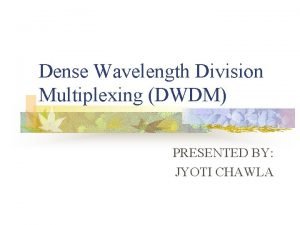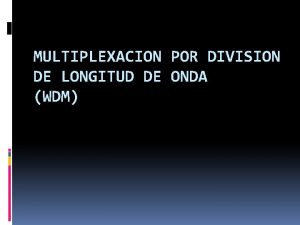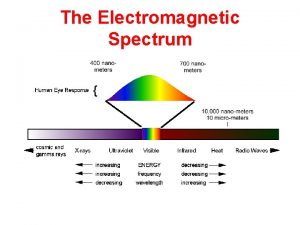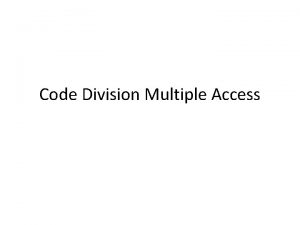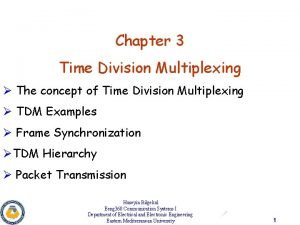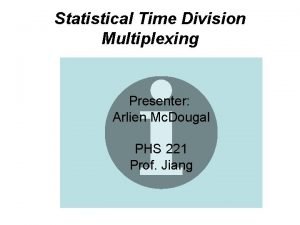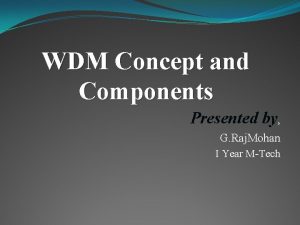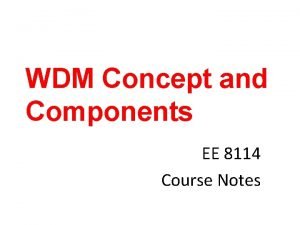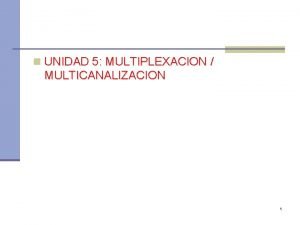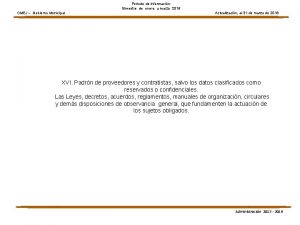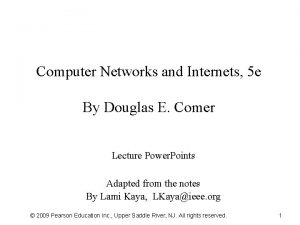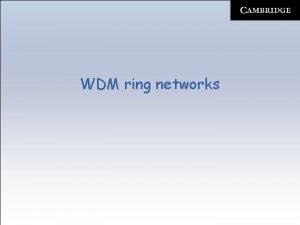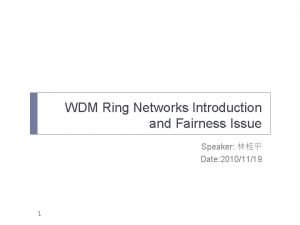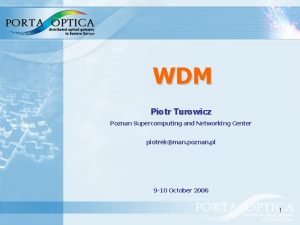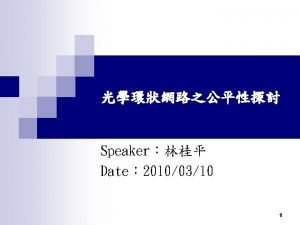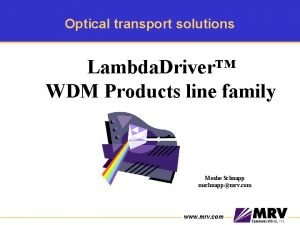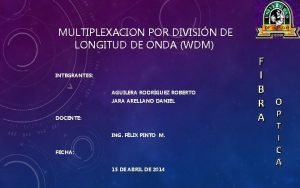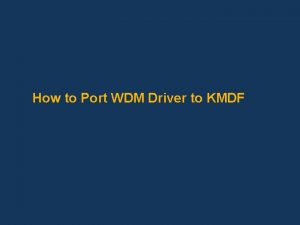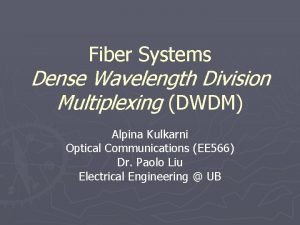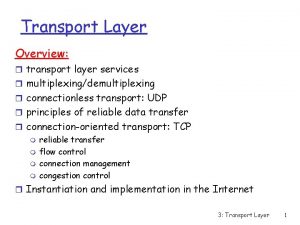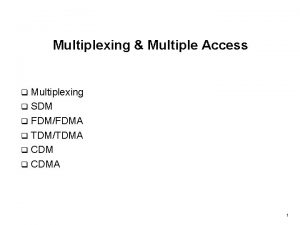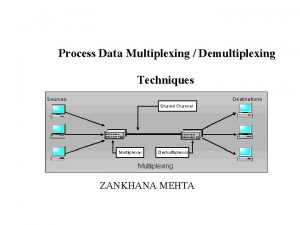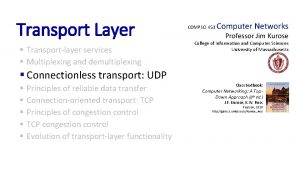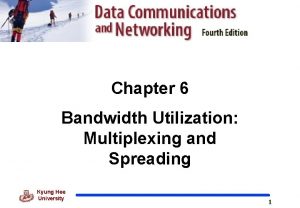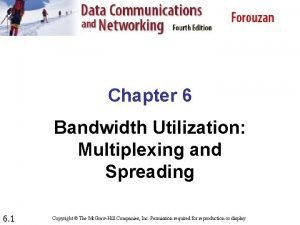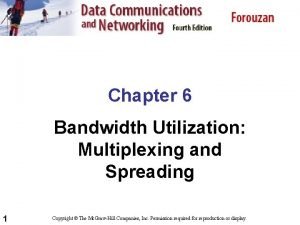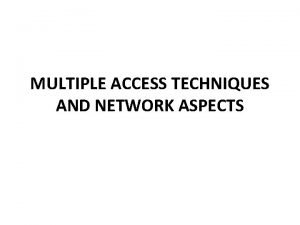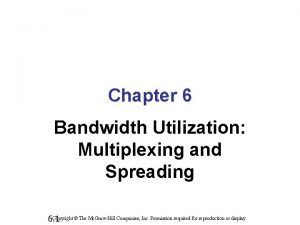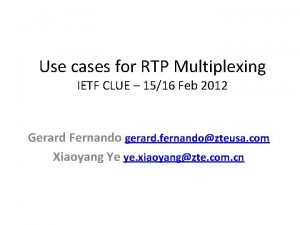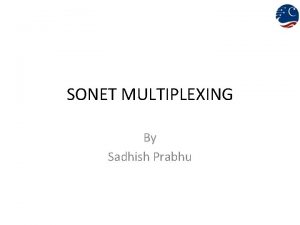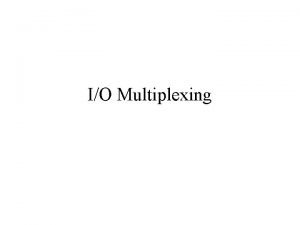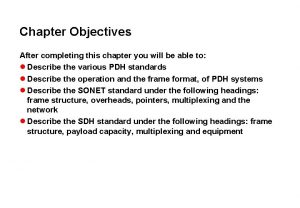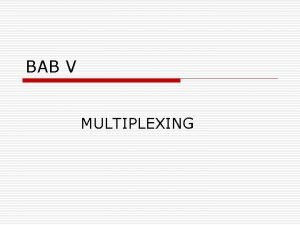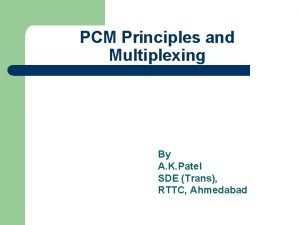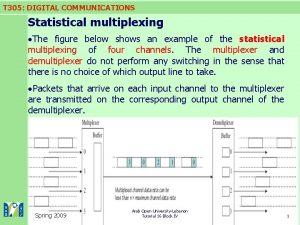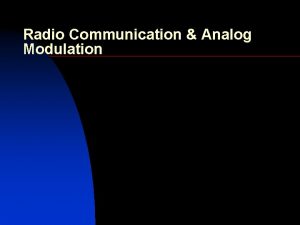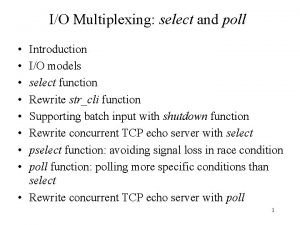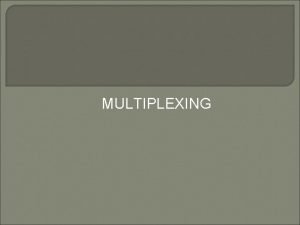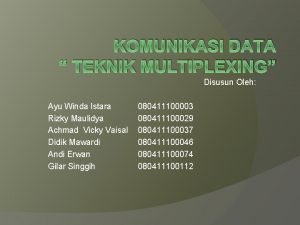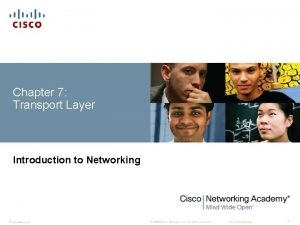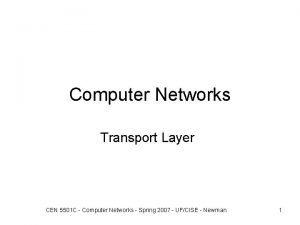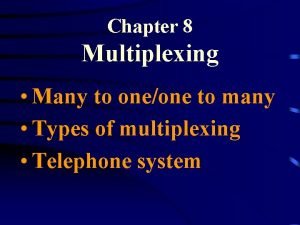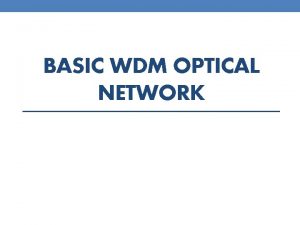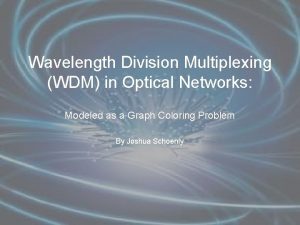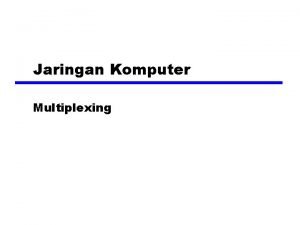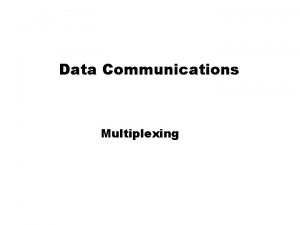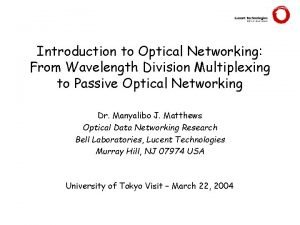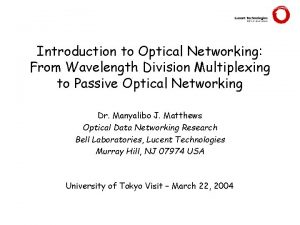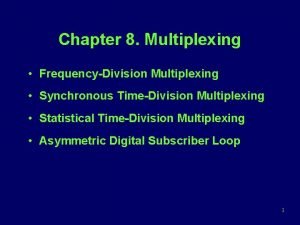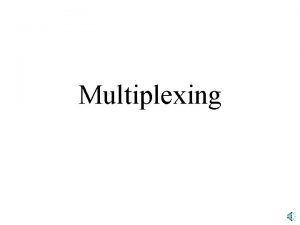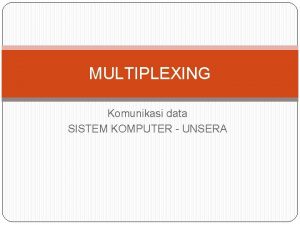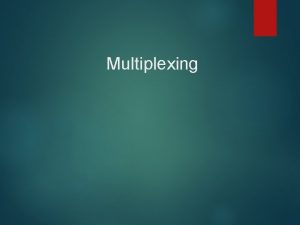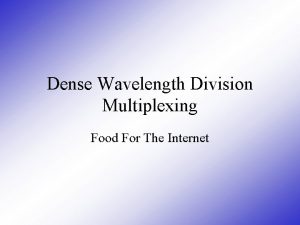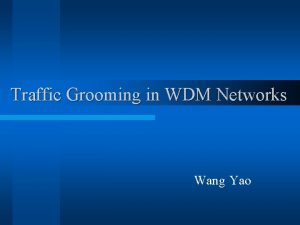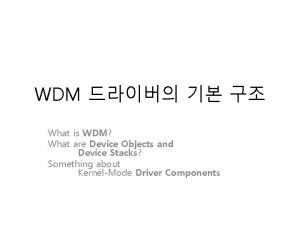The Optical Internet Wavelength Division Multiplexing WDM and

















![Optical Core Properties [Potentially] inexpensive (low CAPEX) Low cost material Low cost process [when Optical Core Properties [Potentially] inexpensive (low CAPEX) Low cost material Low cost process [when](https://slidetodoc.com/presentation_image_h2/8fe50afb59346ef90e56a1e89067bb3a/image-18.jpg)
































- Slides: 50

The Optical Internet Wavelength Division Multiplexing (WDM) and Lambda Switching Optical Internet - 1

WDM: Wavelength Division Multiplexing Transmission of multiple light signals (wavelengths) on the same strand of fiber DWDM - Dense WDM More sophisticated more expensive CWDM - Coarse WDM Lower Optical Internet - 2 number of wavelengths cheaper

Initial WDM Application Increase transmission capacity of fiber Trunk bandwidth Increase the utilization (ROI: return of investment) of [existing] fiber Point to point configurations Optical Internet - 3

Taking it a step further: Wavelength Switching Optical Internet - 4

Add/drop multiplexing “Interim” WDM Application OC-48/192 POS Gigabit Ethernet ATM Sw OADM OC-3/12, DS 3 ATM ADM Edge Rtr 10/100 BT OC-3/12 POS OADM OC-48 ATM ATM Sw Metro DWDM Ring (OADMs) Gigabit Ethernet OADM ADM OC-48/192 POS Edge Rtr OC-3/12, DS 3 ATM Sw Optical Internet - 5 ATM Sw Core Rtr 10/100 BT OC-3/12 POS Edge Rtr

“Interim” WDM Application Add/drop multiplexing Ring topologies with WDM add/drop multiplexers Optical Add-Drop Multiplexer (OADM) Inserting wavelengths on the ring Extracting wavelengths from the ring Mostly static or semipermanent interconnection configurations Reconfigurable Optical Internet - 6 OADM (ROADM)

Ultimate WDM Application Wavelength switched networks Arbitrary mesh topologies of WDM links and wavelength switches A. k. a. wavelength routers, lambda switches Mostly (“only”) optical cross connects Optical Internet - 7 Optical Switching – Wavelength switching

What to do with Optical Switches? Optical Mesh SONET ADM = WDM Terminal Optical Switch = IP Router or ATM Switch Deployed in the network core because of its coarse bandwidth allocation 1 optical channel: 2. 4 Gb/s or more Optical Internet - 8

Why Optical Switching? It has the potential of being simple, hence delivering a (very) low cost per switched bit Optical Internet - 9

A bit of context A look into the historical moment in which optical switching became popular Optical Internet - 10

Optical Technologies in Terabit Networks Dr. John Ryan Principal & Chief Analyst RHK Optical Internetworking Forum, Atlanta, June 5 th, 2000

The Resulting Traffic Dilemma. . . Traffic . . . And network costs are growing faster than revenues Relative size (1999 = 10) Traffic is growing at explosive rates Costs 10000 Revenues 1000 10 1999 2000 2001 2003 2004 2005 • Optical networks help solve this dilemma -- on a large scale. 5/30/2000 OIF, Atlanta 12

Optics Reshape the Cost Curve $450 400 $400 350 $350 300 $300 250 $250 200 $200 150 $150 100 $100 50 $(000) per gbps 450 Bandwidth Cost Throughput (gbps) • DWDM driving down the cost of trunk bandwidth $50 $0 1994 1995 Throughput 5/30/2000 1996 1997 1998 Cost/gbps OIF, Atlanta 13

Pricing & The Technologies • Prices/OC-48 (2. 5 Gbps) dropping rapidly – in favor of 10 Gbps+ systems 5/30/2000 140 High end router 120 ATM switch 100 $k/OC-48 • By 2002, optical switches could offer the most bandwidth per dollar Price Trends for Core Switches STM switch Optical switch 80 60 40 20 0 1998 1999 OIF, Atlanta 2000 2001 2002 2003 14

Back to the future And to technology, leaving hype behind Optical Internet -

Many Flavors of Optical Switches Optical vs Electronic core Cross Connect vs Switch Wavelength Conversion Different levels of complexity Different levels of flexibility Optical Internet -

Optical Core Deploy physical properties of materials to deflect light from incoming fiber to outgoing fiber Tilting mirrors Micro-electro-mechanical Voltage operated Holographic reflecting surfaces Voltage operated Materials changing properties with Heat Pressure Voltage/current Optical Internet - systems (MEMS)
![Optical Core Properties Potentially inexpensive low CAPEX Low cost material Low cost process when Optical Core Properties [Potentially] inexpensive (low CAPEX) Low cost material Low cost process [when](https://slidetodoc.com/presentation_image_h2/8fe50afb59346ef90e56a1e89067bb3a/image-18.jpg)
Optical Core Properties [Potentially] inexpensive (low CAPEX) Low cost material Low cost process [when technology matures] Bit rate and signal independent Unlimited scalability Multi standard Low power consumption Low operation costs (OPEX) High production costs Immature technology High attenuation (and no regeneration) Optical Internet -

Electrical Core Convert optical signal into an electric one and use a circuit interconnection network Optical-electrical conversion Receive the bits and switch them It looses all the nice properties of an optical core Bit rate independence Low power consumption Low cost However At current state of technology, cheaper Less complex/costly than packet switching Optical Internet -

Cross Connect Fixed/static configuration Changed seldom Through a management system/interface Optical Internet - Usually optical core

Fiber Cross Connect The whole signal from an input fiber switched to an output fiber Micro-electro-mechanical systems (MEMS) Long Optical Internet - re-configuration time Optical amplification might be used before and after switching

Wavelength Cross Connects One (or more) wavelengths from an input fiber to an output fiber WDM de-multiplexer+MEMS Separates different wavelengths in space “Prism” Regeneration may be used before or/and after switching OEO (optical-electrical-optical) conversion with electrical regeneration Requires “receiving” the bits -> bit rate dependent O/E/O Optical Internet - Optical core O/E/O

Switching: the N 2 Problem SEA 20 s = N • (N-1) N 2 CHI NYC 5 s SF LA Optical Internet -

Wavelength Conversion Complex OEO conversion Expensive Non data transparent does not scale Physical properties E. g. , resonance chamber Immature technology -> expensive Does not require the same wavelength endto-end No wavelength assignment problem N 2 problem Optical Internet -

Wavelength cross-connect with Wavelength Conversion One (or more) wavelengths from an input fiber to other one (or others) on an output fiber Electrical core might be used Easier signal monitoring Forward error correction (FEC) possible to reduce Bit Error Ratio (BER) O/E Electrical E/O core Optical Internet -

Wavelength cross-connect with Wavelength Conversion Optical core with OEO (optical-electricaloptical) conversion Also providing signal regeneration O/E/O Optical Internet - Optical core O/E/O

Dynamic Optical Switching Wavelength switch with or without wavelength conversion Switch configuration is changed dynamically By management By time of day By end system signaling Every packet!? ! … Optical packet switching Optical burst switching Optical Internet -

Dynamic Optical Switching Optical core Electroholography, bubbles OEO for regeneration and wavelength O/E/O conversion Optical core Electrical core Possibly SONET/SDH O/E Electrical E/O core Possibly O/E/O multiple OEO for regeneration O/E Electrical E/O core Optical Internet - O/E/O

Deployment Optical Internet -

What is Expected from the Optical Network? Provisioning and protection of lightpaths end-to-end Client equipment (e. g. routers) to control provisioning of optical layer lightpaths Signaling Optical Internet - Cost-effective deployment of flexible networks

Provisioning IP Router Step 1 -Request Bandwidth Optical Internet - Optical Switch Step 2 - Provide New Channel Control Channel

Provisioning Step 6 - Disconnect Channel and Use Elsewhere Step 5 - Release Bandwidth Optical Internet - Control Channel

Protection/Restoration Protection: pre-determined action non-optimal resource utilization Restoration: dynamically determined action optimization of resource utilization Step 4 - Restore Connection Step 3 - Fiber Cut - Hold off Control Channel Optical Internet -

Protection/Restoration Multiple levels of protection: Layer 1 optical, e. g. SONET-like Layer 2 data link bundle Layer 2. 5 protected MPLS LSPs Layer 3 routing Multiple layers of restoration can be triggered Each different timescales for detection and repair Must avoid: Unnecessary traffic shifting Packet loss, reordering, control plane churn Pathological feedback Non self-stabilizing Optical Internet -

Control Plane Optical Internet -

What Optical Switches Need Resource discovery Topology Access points and node identification Resource usage Connection management/signaling Lightpath setup Lightpath take down Lightpath modification Distributed routing Mesh/ring network protection and recovery Establishment of protection service classes Optical Internet -

What Optical Network Users Need Resource discovery Address network of users reachable through the optical Manage lightpaths Lightpath setup Lightpath take down Lightpath modification Negotiate protection service classes Protected, unprotected, best effort lightpaths Does all this sound familiar? ATM Optical Internet -

Routing In the Optical Internet network users are routers Overlay Model The optical network provides connectivity between routers Routers see the optical network as a black box Routers might be provided with reachability information Peer Model Routers and switches participate to the same routing protocols Routers know the topology of the optical network Routers can choose the preferred path for lightpaths between them To reach specific destinations Optical Internet -

How to Do It How is the optical network controlled? Layer 3 control plane? MPLS/LDP? LSPs mapped over wavelengths OSPF, BGP 4? New signaling and routing standards? Proprietary vendor specific? Out of band or in-band Ethernet Optical Internet - control channel

MPLS the only sensible choice for the Optical Network Control Plane MPλS - Multi-Protocol Lambda Switching OSPF, IS-IS, BGP for resource discovery RSVP/LDP for signaling Optical Internet -

Players in the Optical Arena Optical Internet -

Standardization ITU-T - International Telecommunication Union - Telecommunication Sector OTN - Optical Transport Network Recommendation G. 872 ASON - Automatic Switched Optical Channel Networks IETF - Internet Engineering Task Force MPLambda. S Optical Internet - - Multi-Protocol Lambda Switching MPLS signaling

Fora - Consortia OIF - Optical Internetworking Forum Focus on SONET Adopting MPLS signaling ODSI - Optical Domain Service Initiative Service No Optical Internet - NNI inteface

Data Transport and Protocol Stack Optical Internet -

IP over Glass … Fundamental IP over Photons … Not Exactly requirement for Internet Applications Virtual circuits IP ATM SONET/SDH Raw Bandwidth! Optical Internet - OPTICAL Fast fault protection

Data Transport Physical Layer -> transfer of bits SONET/SDH Ethernet Digital Wrapper Data link layer -> framing PPP with HDLC framing PPP with SDL framing Ethernet PPP - Point-to-Point Protocol ATM HDLC - High-level Data Link Control MPLS? SDL - Simple Data Link ATM - Asynchronous Transfer Mode Network layer: IP Optical Internet -

Some Encapsulation Options IP IP IP MPLS PPP PPP HDLC SDL HDLC SONET WDM WDM Optical Internet - IP IP LLC ATM SONET WDM MPLS PPP ATM HDLC SONET Digital Wrapper Ethernet WDM WDM IP Ethernet SONET WDM

Point-to-Point Protocol (PPP) High-Level Data Link Control (HDLC) framing 1 1 1 2 Flag 01111110 Address 1111 Control 00000011 Protocol 2 Packet Length 2 o 4 Information FCS 1 Flag 01111110 Simple Data Link (SDL) framing 2 Header CRC Optical Internet - variable 1 Address 1111 hunting 1 Control 00000011 2 Protocol variable Information 2 o 4 SDL CRC

Po. S: Packet Over SONET Use SONET/SDH physical layer for transmission of bits No SONET switching No SONET (de)grooming No SONET (de)multiplexint Channels Way to encapsulate IP packets in SONET frames One SONET channel per link/optical channel PPP deployed Optical Internet -

Digital Wrapper Improve Bit Error Ratio (BER) Provide transparent transport PAYLOAD FEC Data OCh-OH OCh - Optical Channel OH - Overhead FEC - Forward Error Correction Optical Internet - 50
 Dwdm
Dwdm Upward and downward multiplexing
Upward and downward multiplexing Upward and downward multiplexing
Upward and downward multiplexing Multiplexación por división de longitud de onda (wdm)
Multiplexación por división de longitud de onda (wdm) Shortest to longest wavelength
Shortest to longest wavelength Code division multiplexing
Code division multiplexing Block diagram of tdm system
Block diagram of tdm system What is statistical time division multiplexing
What is statistical time division multiplexing Ofdm
Ofdm Wdm concept
Wdm concept Wdm concept
Wdm concept Aircraft maintenance manual
Aircraft maintenance manual Multicanalizacion
Multicanalizacion Wdm 990126350
Wdm 990126350 Fdm tdm wdm in computer networks
Fdm tdm wdm in computer networks Wdm ring
Wdm ring Wdm network
Wdm network Wdm
Wdm Ftコミュニケーションズ 交換機
Ftコミュニケーションズ 交換機 Wdm products
Wdm products Wdm
Wdm Wdftimerstart
Wdftimerstart Fiber optic wdm
Fiber optic wdm Short division vs long division
Short division vs long division Long division repeated subtraction
Long division repeated subtraction Syntehtic division
Syntehtic division Factoring polynomials using synthetic division
Factoring polynomials using synthetic division Transport layer handles multiplexing and demultiplexing
Transport layer handles multiplexing and demultiplexing Difference between multiplexing and multiple access
Difference between multiplexing and multiple access What is multiplexing and demultiplexing
What is multiplexing and demultiplexing Multiplexing and demultiplexing in transport layer
Multiplexing and demultiplexing in transport layer Multilevel multiplexing
Multilevel multiplexing Multilevel multiplexing
Multilevel multiplexing Bandwidth utilization multiplexing and spreading
Bandwidth utilization multiplexing and spreading Internet access techniques
Internet access techniques What is multiplexer
What is multiplexer Rtp multiplexing
Rtp multiplexing Sonet multiplexing
Sonet multiplexing Io multiplexing
Io multiplexing Sdh multiplexing structure
Sdh multiplexing structure Multiplexing adalah
Multiplexing adalah Pcm multiplexing
Pcm multiplexing Statistical multiplexing example
Statistical multiplexing example Modulation multiplexing
Modulation multiplexing Io multiplexing
Io multiplexing Fungsi multiplexing
Fungsi multiplexing Teknik multiplexing
Teknik multiplexing Conversation multiplexing
Conversation multiplexing Spatial multiplexing
Spatial multiplexing Upward multiplexing
Upward multiplexing Multiplexing adalah
Multiplexing adalah
